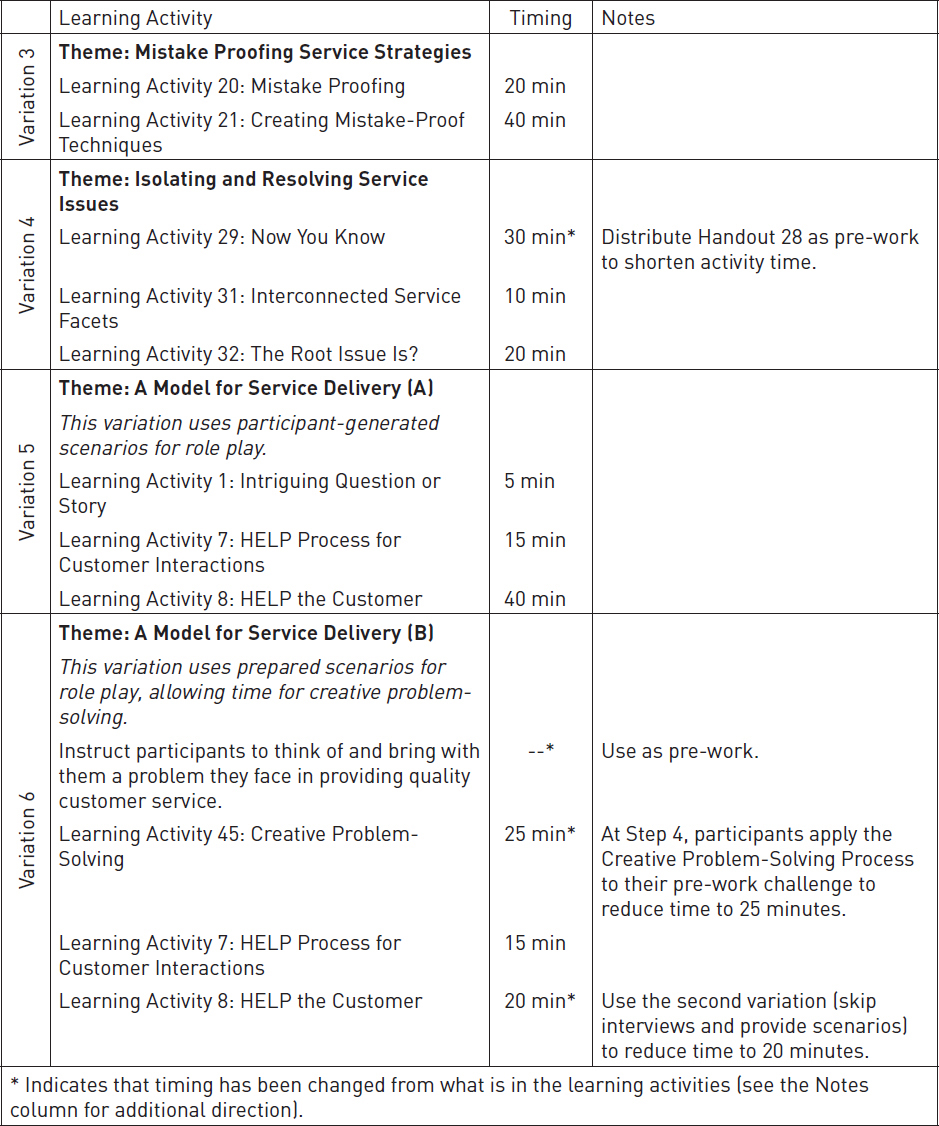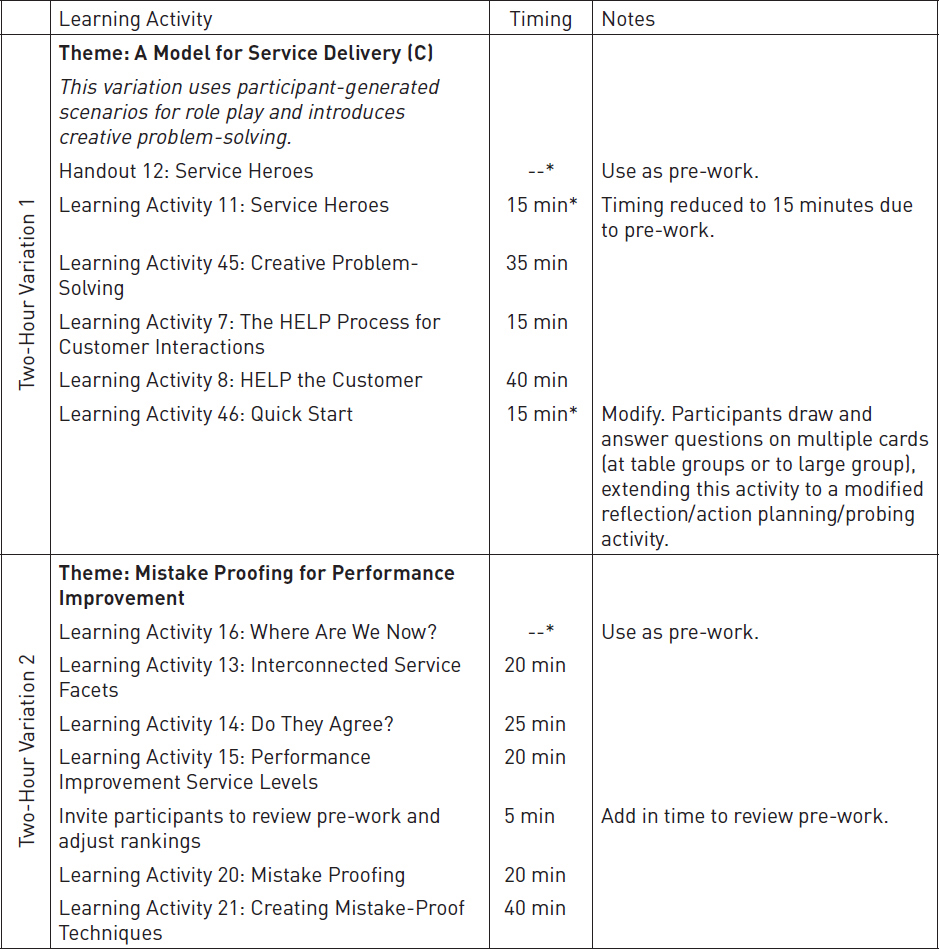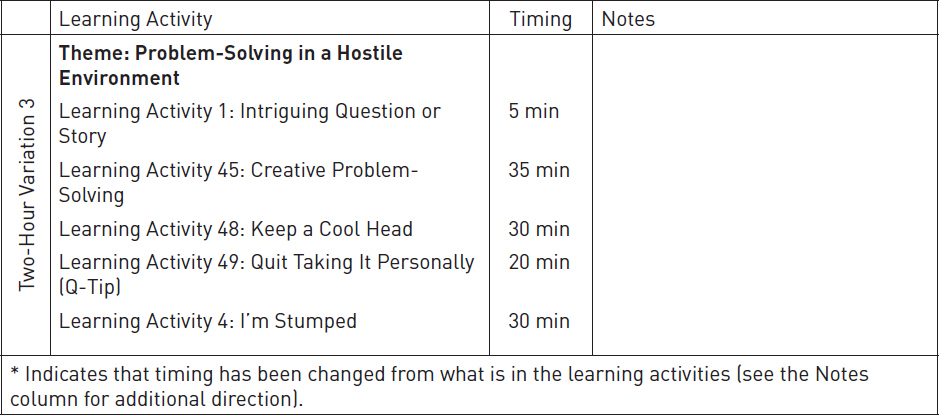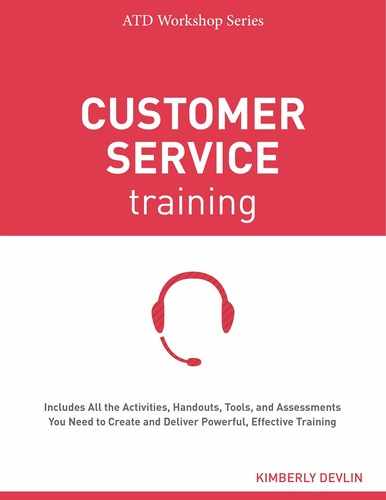Chapter 4
Customizing the Customer Service Workshops
What’s in This Chapter
• Introducing critical steps for customization success
• Integrating organizational service standards
• Ideas for customization of content, format, and delivery
![]()
Many organizations are challenged by having employees away from the workplace for an entire day or two, even if it is for professional and skill development. As a result, you may need to adjust and adapt your workshop to the scheduling needs of the organization. Additionally, the content and topics of your workshop truly must match the needs of the employees attending the training. Therefore, your training needs analysis will help you select the workshop best suited to your participants’ needs and guide your decisions in customizing the content and activities. For more on needs analysis, see Chapter 5.
The materials in this ATD Workshop Series volume are designed to meet a variety of business needs. They cover multiple topics within three key aspects of customer service and can be offered in many timeframes and formats. By using the learning content and activities provided here as a foundation, you can modify and adapt the learning experience by customizing the content and activities, customizing the workshop format, and customizing the delivery with technology.
Customizing the Content and Activities
Knowing why you are making changes is fundamental to any customization. You are likely to use the agendas and support materials in this book in one of three ways: 1) pulling an activity or two into a design you are already working on; 2) deploying these workshops as tested, turn-key training events; or 3) using them as the basis of your program but tailoring them to fit your organizational needs. If you fall into the third category, I encourage you to connect the changes you make directly back to the business needs identified during your analysis. Resist the urge to make changes just so they are “different” than the off-the-shelf version.
Striking off on your own can be exciting and intimidating at the same time. If you follow three key steps in your customization efforts, you will be primed for success.
Step One: Get Real
Foundational to your customization of the workshops will be determining the organization’s service culture reality. There may be a framed poster in the lobby citing service as a core value, but is that being demonstrated? If not, why not? And, if it is, how often and by whom? When customers call the service center, are those experiences consistent with the service levels provided by all of the technicians that come out to make repairs? Walking through the plant, can all employees tell you what the organization’s service expectations are and how that relates to their roles? If asked about the lobby poster, will employees tell you that it was the pet project of the former administrator?
Case in point: I was leading a program in the offices of a client organization and saw an attractive and intriguing wall poster mounted in the back of the room. I referred to it and asked the group for some background on it. It was developed as a support tool for a reorganization, they told me. They quickly added they had been through six additional reorganizations since that one, and right beside it was a poster of another one of the reorganizations.
Just because it is on a wall, website, or company brochure doesn’t mean it is in the culture of the organization. If you go into any of the workshops in this book without a true understanding of the service realities and challenges that may exist, many participants will likely view you as a cheerleader, label the workshop as flavor-of-the-month training, and disconnect. You want to avoid that!
In the most challenged of service environments, you might consider opening a workshop with a few direct questions that will shake up the status-quo, place the issues on the table, and engage your participants:
• Why isn’t service a priority here?
• What indicators lead you to believe that leadership doesn’t value service?
• Are you truly doing all you can to provide exceptional service? Why not?
Step Two: Be Relevant
To be effective, training must be relevant. No one wants to have their time wasted. You can build relevance into your workshop design in several ways:
• Align content and format with organizational needs. The introduction to this book provides a guide to choosing the best workshop to align with your organizational needs. Choose a workshop because of its alignment—not its duration. And then communicate the rationale for your choice. Communicate it to workshop sponsors and champions, communicate it to subject matter experts (SMEs) and co-facilitators, and, of course, communicate it to the participants.
• Create custom scenarios for role plays. During your needs analysis, inquire about the types of challenging situations that employees in the organization encounter in delivering customer service. Drawing from that information and then fictionalizing it, draft scenarios to use as a learning lab during the workshop. They can be integrated as case studies, role plays, match-a-strategy activities (where participants connect workshop tools or techniques to specific situations), and so on.
• Share industry-specific examples and stories. Replacing sample stories provided in this volume with content that is directly applicable to the participants instantly builds in relevance. In a large-scale rollout, that will likely mean creating multiple sets of stories and scenarios, tailored to each participant subset of the organization. Engineers, marketing specialists, sales staff, and security personnel will not all relate to the same situations even if they are employed by the same organization.
• Use industry-specific terminology. For customer service training, customization must carry over even to the language used to describe the people involved in the service interaction. Although the term customer is used to describe the recipient in the support materials provided with this volume, you may want to change that designation throughout. Your industry may use terms such as client, guest, visitor, patron, resident, citizen, taxpayer, or patient. Similarly, the people providing service may be called employees, associates, ambassadors, client representatives, customer care agents, or staff. Update terminology accordingly; give your participants as many points as possible to identify with the workshop content.
Step Three: Integrate the Organization’s Service Standards
What does it look like to live up to the service expectations of the organization? How you answer this question depends on the organization and its service standards. Service standards set the measurable level of performance that customers should receive under normal circumstances. They are stated goals for service achievement and commitments to the customers—both external and internal. They have two main purposes: provide employees with performance targets (“resolve customer issues in one phone call”) and set expectations for customers (“hold time for callers is under 10 minutes”). Here are several ideas to keep in mind when integrating your organization’s service standards into your workshop:
• Develop service standards if they don’t already exist. If your organization doesn’t have service standards, you may want to tackle creating them. Writing effective service standards can be challenging because they require a high degree of specificity in the language and yet must be broadly applicable to all employees. The goal is to develop standards that are measurable, ambitiously realistic, and relevant to the customer. If you are leading the charge to establish standards, be sure to involve as many viewpoints and stakeholders as possible in the process, including customers, managers, frontline employees, service delivery partners, and executive leaders.
• Build service standards into workshop design. If the organization has a set of service standards, you might consider an icebreaker activity that requires assembling all of the service standard elements, a timed game of charades to act them out, or trio exchanges in which each participant shares a two-minute story of how they applied a service standard. Then, circle back to the standards throughout the workshop as you facilitate the learning activities. Ask participants how a particular skill or behavior supports the standards. Challenge the group to look for and share connections between the workshop content and the service standards.
• Swap out some of the learning objectives to align with service standards. Tailoring activities alone may not be enough. Consider modifying the learning objectives as well and then pairing them with new activities. Here are examples of two easy swaps you could make:
![]() For a service standard on empathy, for example, replace a service behavior learning objective with one for reflective listening. Then add a new learning activity that focuses on listening skills.
For a service standard on empathy, for example, replace a service behavior learning objective with one for reflective listening. Then add a new learning activity that focuses on listening skills.
![]() For a service standard on timeliness, replace a service strategy learning objective with one for effective time management practices and pair it with a time management exercise.
For a service standard on timeliness, replace a service strategy learning objective with one for effective time management practices and pair it with a time management exercise.
Customizing the Workshop Format
Although extended immersion in a learning environment can increase the depth of learning experiences, workplace realities sometimes require that training be conducted in short, small doses. The resources and materials provided in this book can be used to build a variety of learning experiences. Chapter 10 includes ideas to “Continue to Offer Learning Opportunities” that include additional training topics and possible lunch-and-learn formats. Here, I offer some examples of how to modify the workshops’ content for one- or two-hour sessions, or even a series of short events. (NOTE: The sample one-hour sessions that follow are not intended for use as lunch-and-learn programs, but as dedicated 60-minute learning events. As “lunch-and-learn” implies, such programs take a more informal approach and accommodate participants eating while participating.)
One-hour, Themed Sessions
To address the possible need to provide learning in shorter segments, Table 4-1 breaks down some of the content into six one-hour sessions based on selected themes to be offered as standalone events. You can also consider stringing a few of them together to offer as a series on a daily, weekly, biweekly, or monthly basis, depending on the scheduling needs of the organization. Note that some of the sessions contain duplicate content, so closely review the sample one-hour sessions if you are creating a customized delivery schedule. Some of these sessions may also require additional transitions or openers to deliver a seamless learning event or series.
Table 4-1. Sample One-Hour Formats


Two-hour, Themed Sessions
These sample two-hour sessions may work best when time is constrained, but the service challenges are not. They will delve deeper into a theme, provide participants with a greater complement of tools and strategies, and afford more time for participant-generated challenges, scenarios, and action planning than their one-hour counterparts. Table 4-2 presents three two-hour sessions that can be offered as standalone learning events. Some of these sessions may require additional transitions or openers to deliver a seamless program.
Table 4-2. Sample Two-Hour Formats


Customizing the Workshop Delivery with Technology
Learning technologies can play an important role in adapting workshops to fit your organization. They have the potential to enhance learners’ abilities to apply workshop concepts and can be especially useful when participants work in different locations. Examples include webinars, wikis, email groups, and teleconferencing, to name just a few. Here are several ideas for incorporating technology into the custom delivery of your workshop:
• Blended learning. Depending on your comfort level and the technology resources available at your organization, you could consider a blended learning approach. Some activities can be done virtually; others cannot. Lead the workshop at least once as instructor-led training so that you understand the flow of the material and to give you ideas about what portions could be conducted effectively online.
• Before the workshop. Before your participants ever walk into your session, consider sending them a link to a great article or video clip to get them thinking about the workshop content.
• After the workshop. Use surveys and polling tools to assess how workshop skills are or are not being applied so you can address any gap. Continue the participants’ focus on the training topic with blog posts that can be pushed out to email boxes using an RSS feed for those who wish to receive them. Create a group site, social network, or SharePoint site to share just-in-time online resources such as reference sheets or job aids.
Learn more about how to use technology to maximize learning in Chapter 7 of this book.
The Bare Minimum
With any of these customization options, always keep in mind the essentials of training design (Chapter 6) and delivery (Chapter 8). At a bare minimum, remember these basics:
• Relevancy! Ensure your scenarios and examples are relevant not just to the organization as a whole but also to the specific participant group in your workshop. After all, the service challenges that a school district’s custodial staff deals with are different than those of its bus drivers, administrative personnel, or teachers. Each subaudience’s environment should be considered when gathering analysis data; designing follow-up activities; and preparing stories, scenarios, and examples for the workshops.
• Less is more. When customizing, avoid the common tendency of packing more “stuff” into the workshop schedule for fear there won’t be enough material. Prioritizing adequate time for participant application is essential because it is during engaging and interactive activities that the learning actually takes place.
• Check yourself … and your materials. The materials in this book have been designed, proofread, tested, and reviewed. Once you begin to make alterations, you will need to compile and carefully review all agendas, activities, handouts, assessments, and slides. Be sure that you ask—and answer—these questions: Have you introduced any contradictions? Do references within your materials match up? Are slides consistent with edits you made to printed materials? Do activity instructions (on handouts, assessments, slides, or facilitator notes) need to be updated? Do the timings on your agenda add up to the total time of your workshop? Have you maintained sufficient time in the agenda for breaks? Double-check. Then triple-check!
What to Do Next
• When customizing a workshop it is important to have a clear understanding of the learning objectives. Conduct a needs analysis to identify the gap between what the organization needs and what the employees are able to do and then determine how best to bridge the gap. At a minimum, identify who wants the training, how the results will be defined, why the training is being requested at this time, and what the budget is. Chapter 5 provides more guidance on identifying training needs.
• Modify or add your own content to an existing agenda from Chapters 1-3 or create your own agenda using the learning support documents included in this book. There is no one way to flow customer service content, but you must ensure that the topics build on one another and that you solidly connect the concepts and ideas together to leverage the most of the learning opportunity.
• Make sure to maintain an emphasis on interactive practice activities in the final design of your workshop.
• Build a detailed plan for preparing for your session, including scheduling and room reservations, invitations, supply list, facilitation notes, and time estimates. A starting point is included for you at the end of each agenda in Chapters 1-3.
